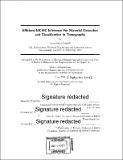| dc.contributor.advisor | John W. Fisher III. | en_US |
| dc.contributor.author | Khojandi, Aryan Iden. | en_US |
| dc.contributor.other | Massachusetts Institute of Technology. Department of Electrical Engineering and Computer Science. | en_US |
| dc.date.accessioned | 2018-01-12T21:16:07Z | |
| dc.date.available | 2018-01-12T21:16:07Z | |
| dc.date.copyright | 2016 | en_US |
| dc.date.issued | 2016 | en_US |
| dc.identifier.uri | http://hdl.handle.net/1721.1/113183 | en_US |
| dc.description | Thesis: M. Eng., Massachusetts Institute of Technology, Department of Electrical Engineering and Computer Science, 2016 | en_US |
| dc.description | Page 106 blank. Cataloged from PDF version of thesis. | en_US |
| dc.description | Includes bibliographical references (pages 103-105). | en_US |
| dc.description.abstract | Inferring the distribution of material in a volume of interest based on tomographic measurements is a ubiquitous problem. Accurate reconstruction of the configuration is a daunting task, especially when the sensor setup is not sufficiently comprehensive. The inverse problem corresponding to this reconstruction task is almost always ill-posed, but reasoning about the latent state remains possible. We investigate the problem of classifying volumes into object classes, using the latent configuration as an intermediate representation. We use the framework of Probabilistic Inference to implement MCMC sampling of realizations of the latent configuration conditioned on the measurements. We exploit conditional-independence properties of the graphical-model representation to sample many nodes in parallel and thereby render our sampling scheme much more efficient. We then reason over the samples and use a neural network to classify them. We demonstrate that classification is far more robust than reconstruction to the removal of sensors and interrogation angles. We also show the value of using the intermediate representation and a generative physics-based forward model by comparing these classification results with those obtained by foregoing the latent space and training a classifier directly on the sensor readings. The former benefits from regularization of the posterior distribution, allowing it to learn more rapidly and thereby perform significantly better when the number of labeled examples is limited, a reality present in the context of our problem and in many others. | en_US |
| dc.description.statementofresponsibility | by Aryan Iden Khojandi. | en_US |
| dc.format.extent | 106 pages | en_US |
| dc.language.iso | eng | en_US |
| dc.publisher | Massachusetts Institute of Technology | en_US |
| dc.rights | MIT theses are protected by copyright. They may be viewed, downloaded, or printed from this source but further reproduction or distribution in any format is prohibited without written permission. | en_US |
| dc.rights.uri | http://dspace.mit.edu/handle/1721.1/7582 | en_US |
| dc.subject | Electrical Engineering and Computer Science. | en_US |
| dc.title | Efficient MCMC inference for material detection and classification In tomography | en_US |
| dc.title.alternative | Efficient Markov Chain Monte Carlo inference for material detection and classification In tomography | en_US |
| dc.type | Thesis | en_US |
| dc.description.degree | M. Eng. | en_US |
| dc.contributor.department | Massachusetts Institute of Technology. Department of Electrical Engineering and Computer Science | en_US |
| dc.identifier.oclc | 1017566797 | en_US |
| dc.description.collection | M.Eng. Massachusetts Institute of Technology, Department of Electrical Engineering and Computer Science | en_US |
| dspace.imported | 2019-06-17T20:35:48Z | en_US |
